Taxonomic observations on the poorly known genera Isaeus and Tampiconus (Opiliones: Laniatores: Stygnopsidae)
Jesús A. Cruz-López a, b, *, Oscar F. Francke a
aColección Nacional de Arácnidos, Departamento de Zoología, Instituto de Biología, Universidad Nacional Autónoma de México, Apartado postal 70-153, 04510 Ciudad de México, Mexico
bPosgrado en Ciencias Biológicas, Universidad Nacional Autónoma de México, Av. Universidad 3000, Copilco, 04510 Ciudad de México, México
*Corresponding author: thelyphonidito@gmail.com (J.A. Cruz López)
Abstract
Based on the examination of material and photographs of types of Isaeus and Tampiconus (Stygnopsidae), we rediagnose the genus and redescribe the species Isaeus neglectus comb. nov., including new distribution records. Additionally, we consider Tampiconus as a junior synonym of Isaeus, proposing the new combination Isaeus philippii comb. nov. Finally, we discuss the taxonomic status of the genus Isaeus.
Keywords:
Taxonomy; Gonyleptoidea; Harvestmen; New synonymy; Mexico
© 2018 Universidad Nacional Autónoma de México, Instituto de Biología. Este es un artículo Open Access bajo la licencia CC BY-NC-ND
Observaciones taxonómicas sobre los géneros pobremente conocidos Isaeus y Tampiconus (Opiliones: Laniatores: Stygnopsidae)
Resumen
Con base en la examinación de material y fotografías de los tipos de Isaeus y Tampiconus (Stygnopsidae), rediagnosticamos el género y redescribimos la especie Isaeus neglectus comb. nov., incluyendo nuevos registros de distribución. Adicionalmente, proponemos a Tampiconus como un sinónimo posterior de Isaeus, proponiendo la nueva combinación Isaeus philippii comb. nov. Finalmente, discutimos el estatus taxonómico de Isaeus.
© 2018 Universidad Nacional Autónoma de México, Instituto de Biología. This is an open access article under the CC BY-NC-ND license
Palabras clave:
Taxonomía; Gonyleptoidea; Opiliones; Nueva sinonimia;México
Introduction
The harvestman Isaeus mexicanus Sørensen, 1932, described from a single male specimen from Córdoba, Veracruz has had a convoluted taxonomic history since its inception. The generic name was mentioned in passing by Mello-Leitão (1938) and was subsequently synonymized by Goodnight and Goodnight (1953) under the genus Hoplobunus Banks, 1900, with no explanation. Kury and Cokendolpher (2000) and Kury (2003) discovered that this synonymy resulted in a case of secondary homonymy (by implication): the combination Hoplobunus mexicanus (Sørensen, 1932) is a junior homonym of Hoplobunus mexicanus (Roewer, 1915; formerly Haehnelia mexicana); and therefore they proposed the replacement name of Hoplobunus neglectus Kury & Cokendolpher, 2000.
Roewer (1949) described the Mexican genus and species Tampiconus philippii Roewer, 1949 based on a single female from Tampico, Tamaulipas. This taxon has since been only cited in 2 listings (Kury, 2003; Kury & Cokendolpher, 2000) without further information. In a recently proposed phylogenetic hypothesis of Stygnopsidae based on total evidence, Cruz-López and Francke (2017) included morphological data of the holotype of T. philippii, recovering this species as sister group of “Hoplobunus” sp. 0033, a clade completely unrelated to true Hoplobunus. Despite the fact that Cruz-López and Francke (2017) had not examined the holotype of I. mexicanus, they resurrected this genus and species from its synonymy under Hoplobunus, arguing a plausible future study of the types could clarify the status of Isaeus Sørensen, 1932; however, they ignored the replacement name proposed by Kury and Cokendolpher (2000). Recently, we have examined photographs of the type specimen of I. mexicanus, and thus confirmed the identification of topotypes of this species from Córdoba, Veracruz, and nearby localities. We further compared those specimens with the holotype of T. philippii and their place in the phylogeny of Stygnopsidae. In this work we: a) rediagnose and redescribe both the genus and species Isaeus neglectus (Kury & Cokendolpher, 2000) comb. nov., and b) propose the synonymy of Tampiconus Roewer, 1949 under Isaeus, with the new combination Isaeus philippii (Roewer, 1949) comb. nov.
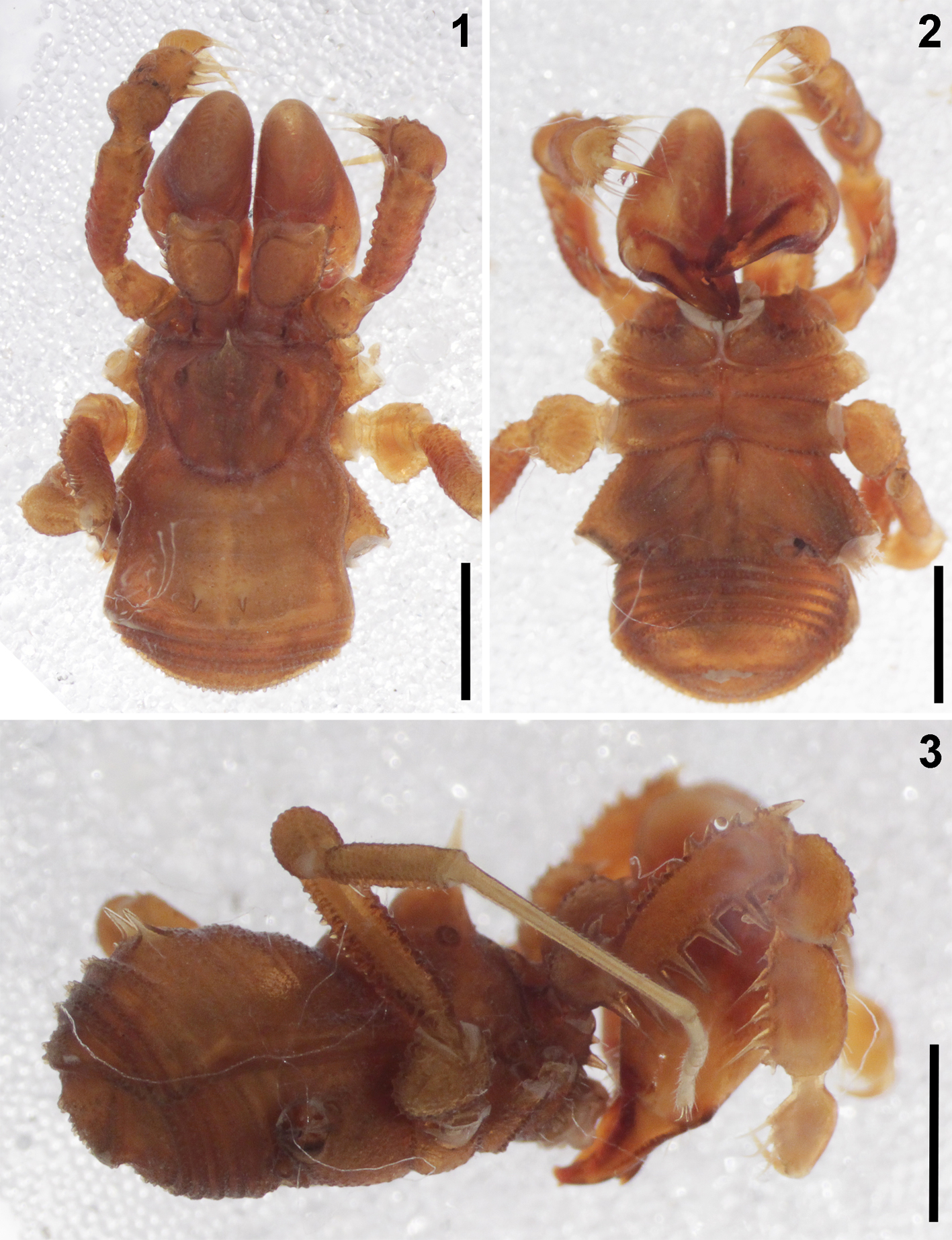
Material and methods
Photographs of the holotypes of I. mexicanus deposited at the British Museum of Natural History (BMNH) and of T. philippii deposited at Senckenberg Museum of Frankfurt (SMF RII 2511/66) were examined. Material of I. neglectus deposited at the Colección Nacional de Arácnidos (CNAN) of the Universidad Nacional Autónoma de México (UNAM) were examined and compared with the photographs of the I. mexicanus holotype. Color images were obtained using a Nikon Coolpix S10 camera attached to a Nikon SMZ645 microscope. Male genitalia were prepared for scanning electronic photographs (SEM) using the procedure described by Acosta et al. (2007). SEM photographs were taken using a Hitachi S-2460N microscope at the Instituto de Biología, UNAM (IB-UNAM) in the Laboratorio Nacional de Biodiversidad (LaNaBio). Photographs were assembled into plates using Photoshop CS5. Nomenclature of scutum follows Kury and Medrano (2016), pedipalpal armature follows Acosta et al. (2007), ratio of the scutum length divided by the cheliceral hand length follows Cruz-López and Francke (2013), and male genitalia follows Kury and Villareal (2015), and Cruz-López and Francke (2017). Abbreviations: MS = macrosetae, RSC = ratio of the scutum length divided by cheliceral hand length.
Description
Order Opiliones Sundevall, 1833
Suborder Laniatores Thorell, 1876
Family Stygnopsidae Sørensen, 1932
Subfamily Stygnopsinae Sørensen, 1932
Genus Isaeus Sørensen, 1932
Isaeus Sørensen, 1932: 275; Goodnight and Goodnight, 1953: 19; Cruz-López and Francke, 2017: 349.
Tampiconus Roewer, 1949 new synonymy
Type species: Isaeus neglectus (Kury & Cokendolpher, 2000) comb. nov., by monotypy.
Included species: Isaeus neglectus and Isaeus philippi (Roewer, 1949) comb. nov.
Diagnosis
Harvestmen with the femur IV shorter than scutum length. Scutum type zeta (ζ), mid-bulge barely convex. Ocularium at the frontal margin of scutum with elliptical base, very wide. Ocularium very robust, with large apical spine. Mesotergum with 4 mesotergal areas, area III and IV fused, with sulcus between them discernible. With 2 paramedian acute spines on the end of mesotergal area III, giving the appearance that the spines are on the sulcus IV (Figs. 1-6, 20, 21). Chelicera large, RSC ~ 1.30, sexually dimorphic, males with larger chelicera than females. Teeth of cheliceral finger similar in size (Figs. 7, 8, 22). Pedipalp strongly armed, femur with ventral row of 5 scattered setiferous tubercles, dorso-apically with acute apophysis. Pedipalpal patella swollen apically, with a ventral setiferous tubercle (Figs. 9-11, 23). Trochanter III globose (Figs. 1, 2, 4, 5). Pars distalis of penis compressed laterally, occupying almost half length of truncus. Flimsy lamina cradle-shaped, short and contiguous with the rest of pars distalis; dorsal portion of the flimsy lamina smooth. Apical depression dorsally tongue-shaped. Follis completely embedded and fitting into the apical depression. Macrosetae arrangement type Stygnopsis: 3 pairs of MS C ventrally, forming a longitudinal row, level to the follis; 2 pairs of both BS A and B, latero-ventrally, in the middle of pars distalis; 2 pair of MS D laterally to follis (Figs. 15-19).
Comparisons. Isaeus can be easily recognized from the cave-dwelling stygnopsine genera Chinquipellobunus Goodnight & Goodnight, 1942, Iztlina Cruz-López & Francke, 2017, Mexotroglinus Šilhavý, 1977, Serrobunus Goodnight & Goodnight, Stygnopsis Sørensen, 1902, Tonalteca Cruz-López & Francke, 2017, and Troglostygnopsis Šilhavý, 1974 by having femur IV shorter than scutum length. Isaeus can be recognized from epigean Paramitraceras Pickard-Cambridge, 1905, Philora Goodnight & Goodnight, 1954, and Sbordonia Šilhavý, 1977 by the absence of lateral channels modified as lateral clear areas with associated pores. The most similar genus is Hoplobunus Banks, 1900, but Isaeus can be recognized from it by the presence of 2 paramedian acute spines on mesotergal area III, and the absence of a median tooth on cheliceral movable finger. Detailed comparisons between Isaeus (= Tampiconus) appear in Cruz-López & Francke (2017: 330).
Isaeus neglectus (Kury and Cokendolpher, 2000) comb. nov., (Figs. 1-19)
Isaeus mexicanus Sørensen, 1932: 275; Cruz-López & Francke, 2017: 349.
Hoplobunus mexicanus Goodnight and Goodnight, 1953: 19 (by implication).
Hoplobunus neglectus Kury and Cokendolpher, 2000: 155 (replacement name due to secondary homonymy with Hoplobunus mexicanus (Roewer, 1915); Kury 2003: 237.
“Hoplobunus” sp. 0033 Cruz-López & Francke, 2017: 330.
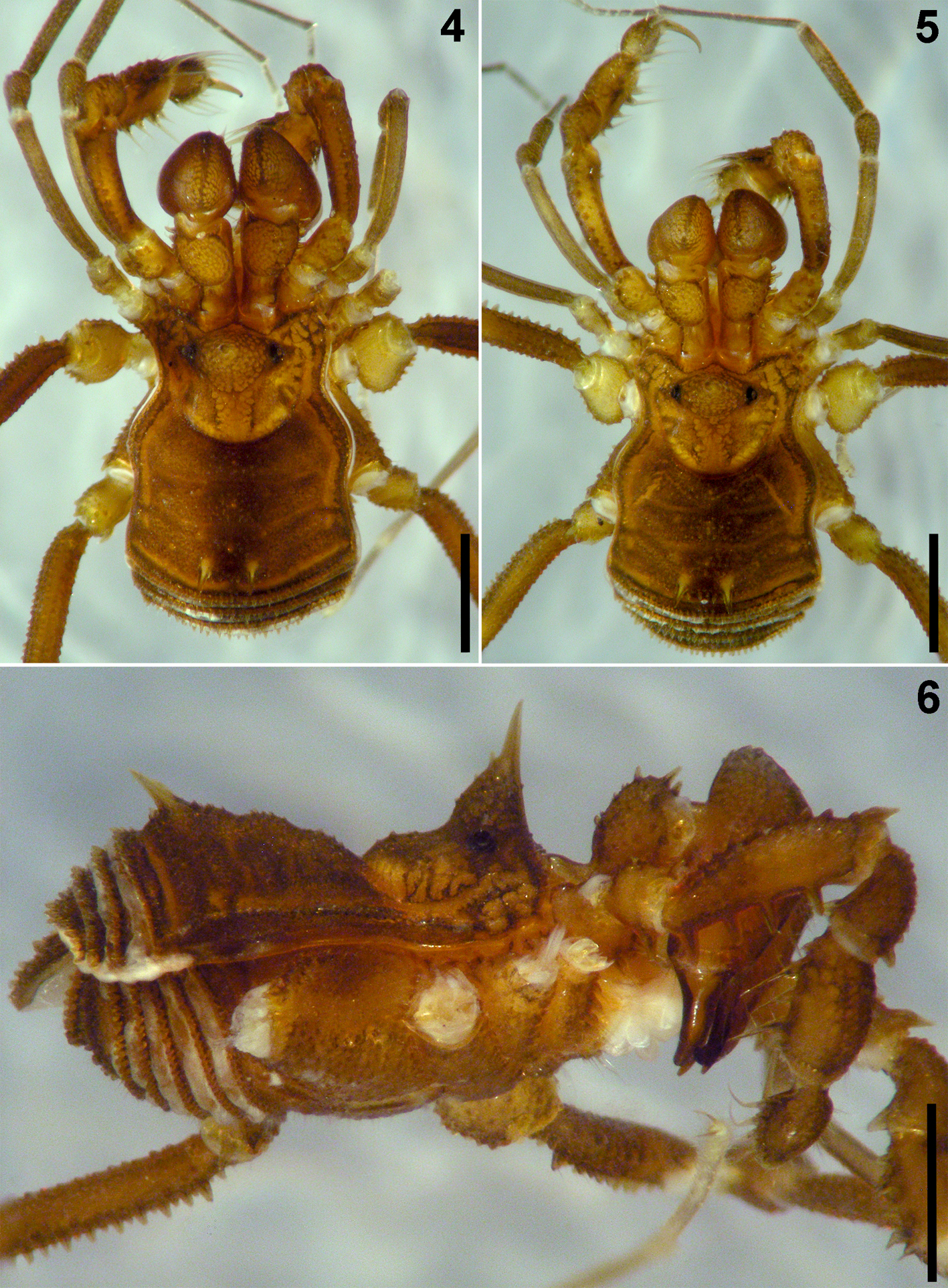
Diagnosis
Four teeth on fixed cheliceral finger on both sexes.
Redescription (male). Scutum length 4.0 mm. Scutum zeta type (ζ), mid-bulge slightly convex, posterior margin slightly wider than scutum width at level of mid-bulge. Ocularium at the frontal margin of scutum, very robust, with the base elliptical and apically armed with large spine. Mesotergum ornate with many small tubercles, covering homogeneously every area. Sulcus I and II almost straight, sulcus III retrocurved and almost absent, areas III and IV barely fused. Area III with a pair of paramedian acute spines, pointing backward. Free tergites and anal plate covered by small spiniform tubercles (Figs. 1, 3, 4-6). Venter: all ventral area covered by small tubercles, coxae IV slightly larger than coxae III, stigmatic area inverse T-shaped, medially constricted, genital operculum small and rounded (Fig. 2). Chelicera: basichelicerite short, with the bulla well marked and ornate with spiniform tubercles. Cheliceral hand swollen, RSC = 1.33, with the dorsal portion elevated. Frontal section of cheliceral hand with many long setae. Fixed finger with 4 small teeth, movable finger with 5 teeth (Figs. 7, 8). Pedipalp: trochanter globular, armed with a long spiniform setiferous tubercle ventrally, dorsally with 4 spiniform tubercles, pointing forward.
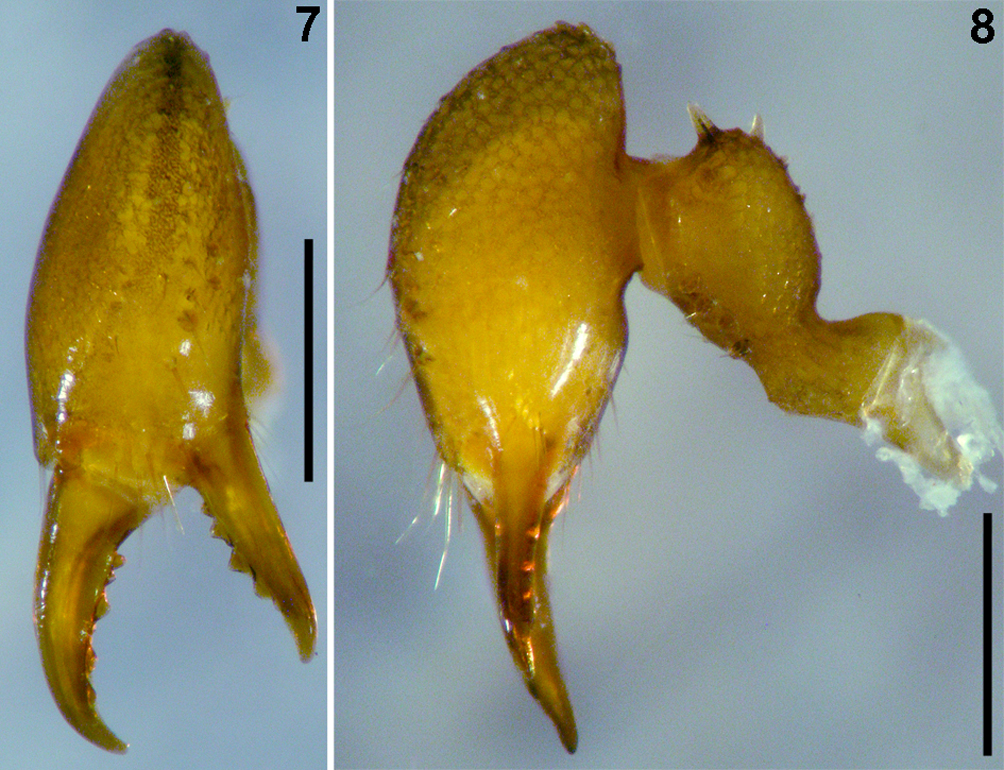
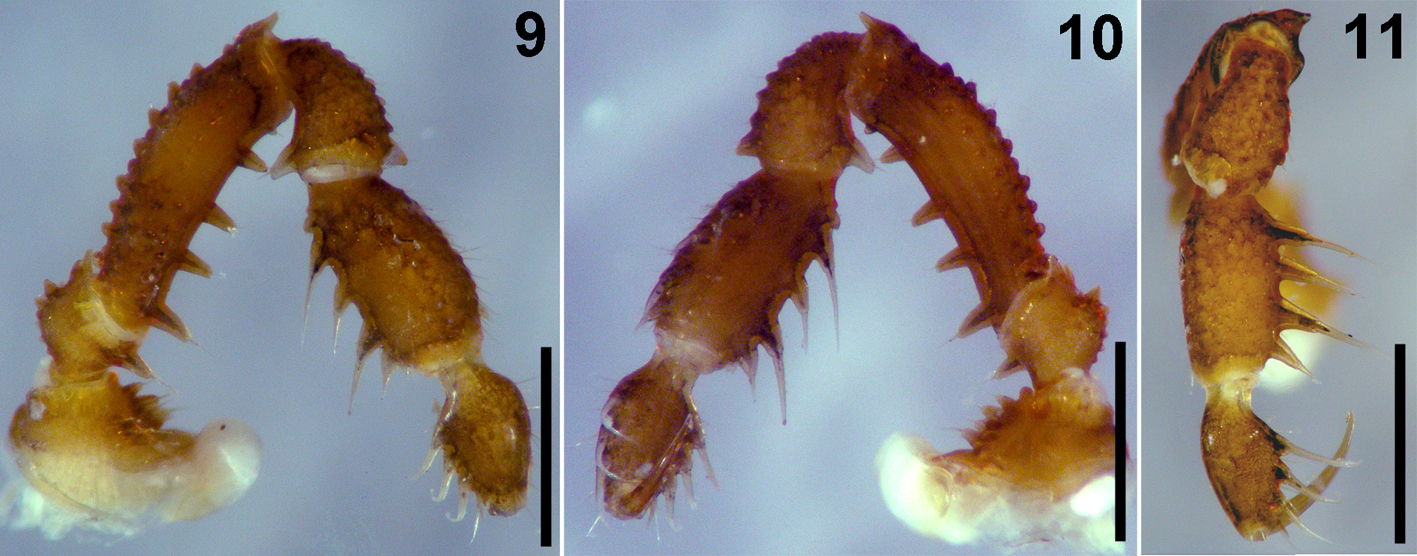
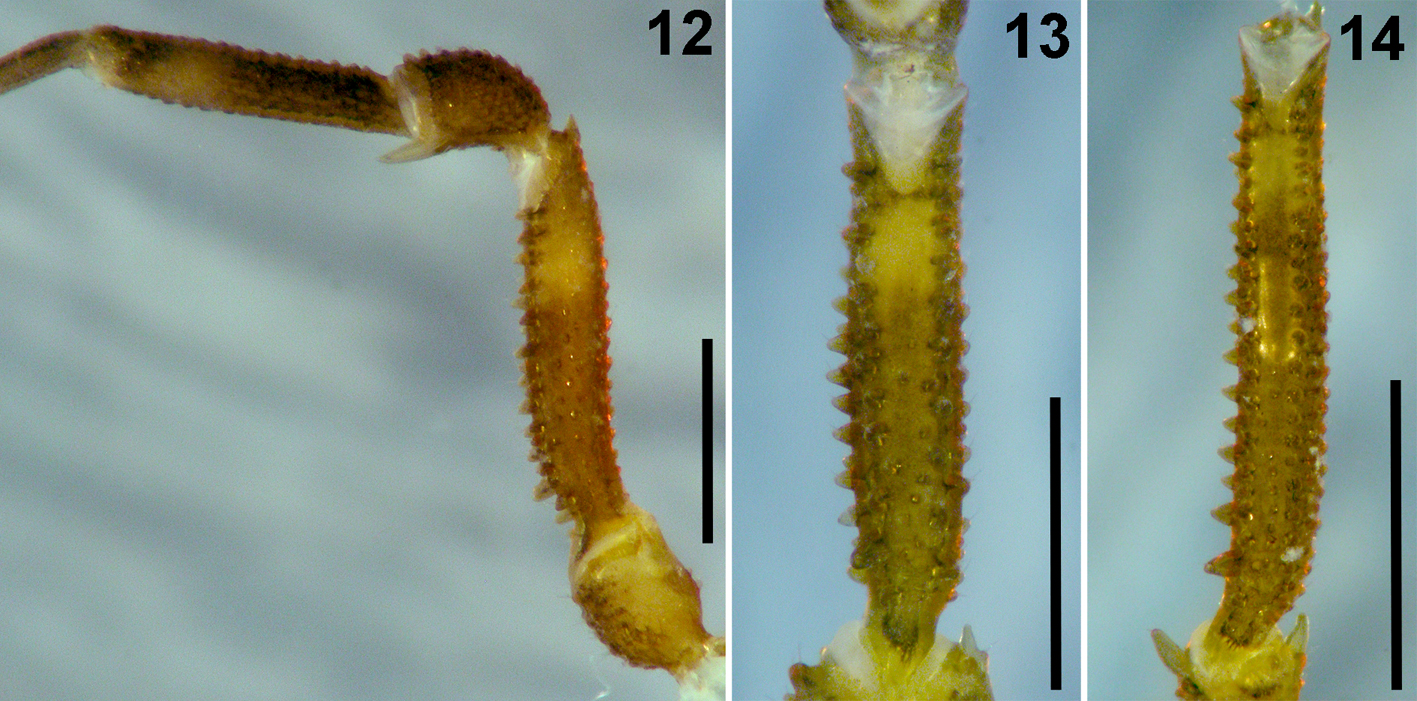
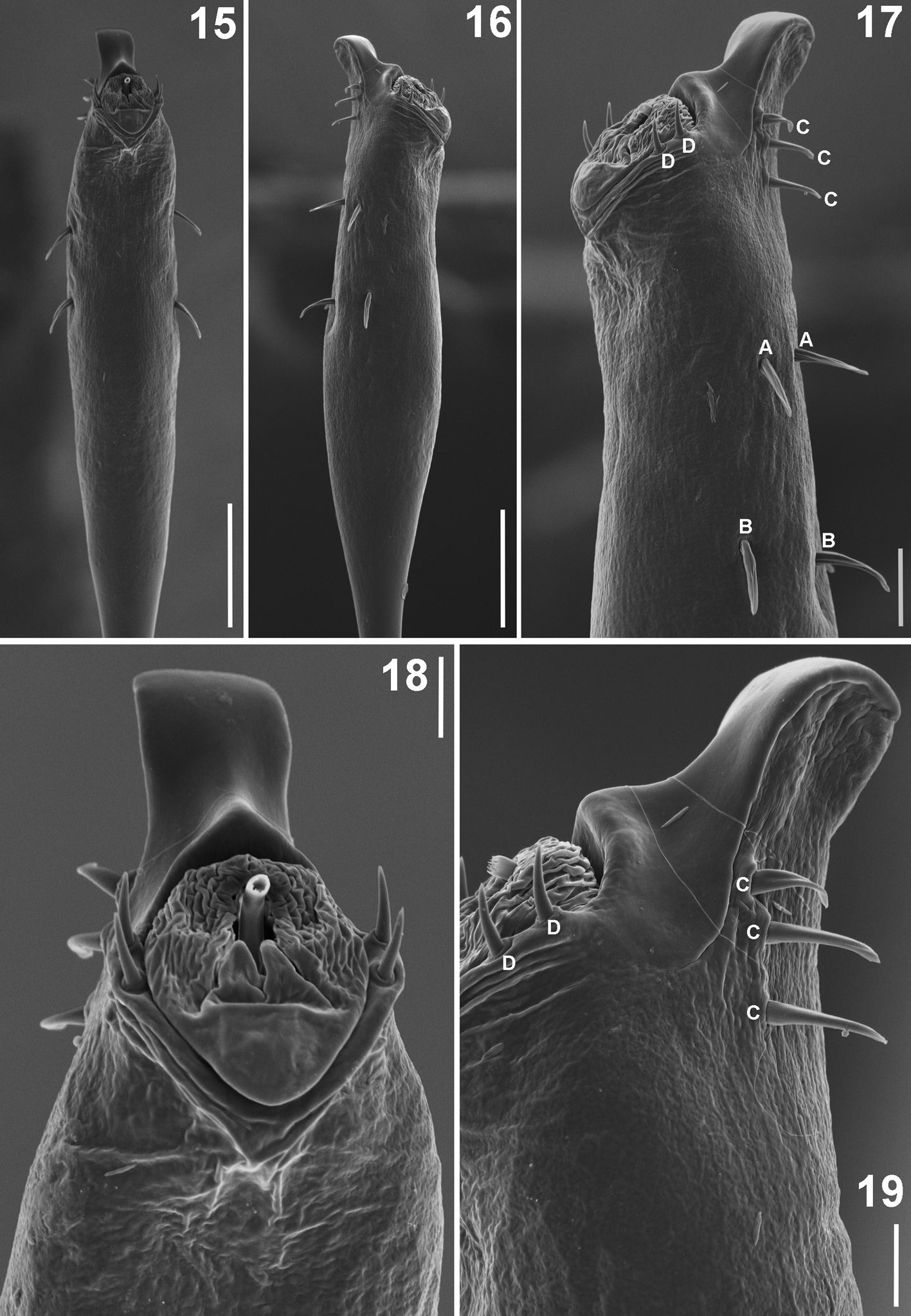
Femur compressed laterally, slightly curved to the inner side, mesal face smooth. Pedipalpal femur with a row of 5 long spiniform setiferous tubercles ventrally, the distal-most is smaller; dorsally with many spiniform tubercles and apical spiniform apophysis. Patella slightly globose, dorsally granulated and with a ventro-apical and a dorso-lateral spiniform apophyses. Tibia with IiIi (1 = 3 > 2 = 4), and tarsus with IIII (1 > 2 > 3 > 4) setiferous spiniform tubercles on both margins, respectively. Tarsal claw similar in length to tarsus (Figs. 9-11). Legs: legs I and II thin and slender; legs III and IV legs more robust than anterior ones, ornated with many spiniform tubercles, these tubercles forming 2 rows longitudinal rows. Trochanters III and IV with a dorsal and a ventral apophyses; patellae III and IV with a ventro-apical spiniform apophyses. With no tarsal process and no scopulae. Tarsal count: 6(2):12(3):7:7 (Figs. 12-14). Penis: pars distalis occupying almost the half length of total truncus, slightly compressed laterally, cylindrical in transversal view. Flimsy lamina cradle-shaped, short and contiguous with the rest of pars distalis; dorsal portion smooth, contrasting with the rest of the truncus. Follis in an inner depression, with dorsal rounded lobe, which fits on dorsal part of pars distalis. Stylus inserted on the follis, barely exposed. Three pairs of MS C ventro-apically, level to the base of flimsy lamina. Two pairs of MS A and B, both on the middle of pars distalis, 1 setae on lateral side and the other ventrally displaced. Two pairs of small MS D laterally to follis (Figs. 15-19).
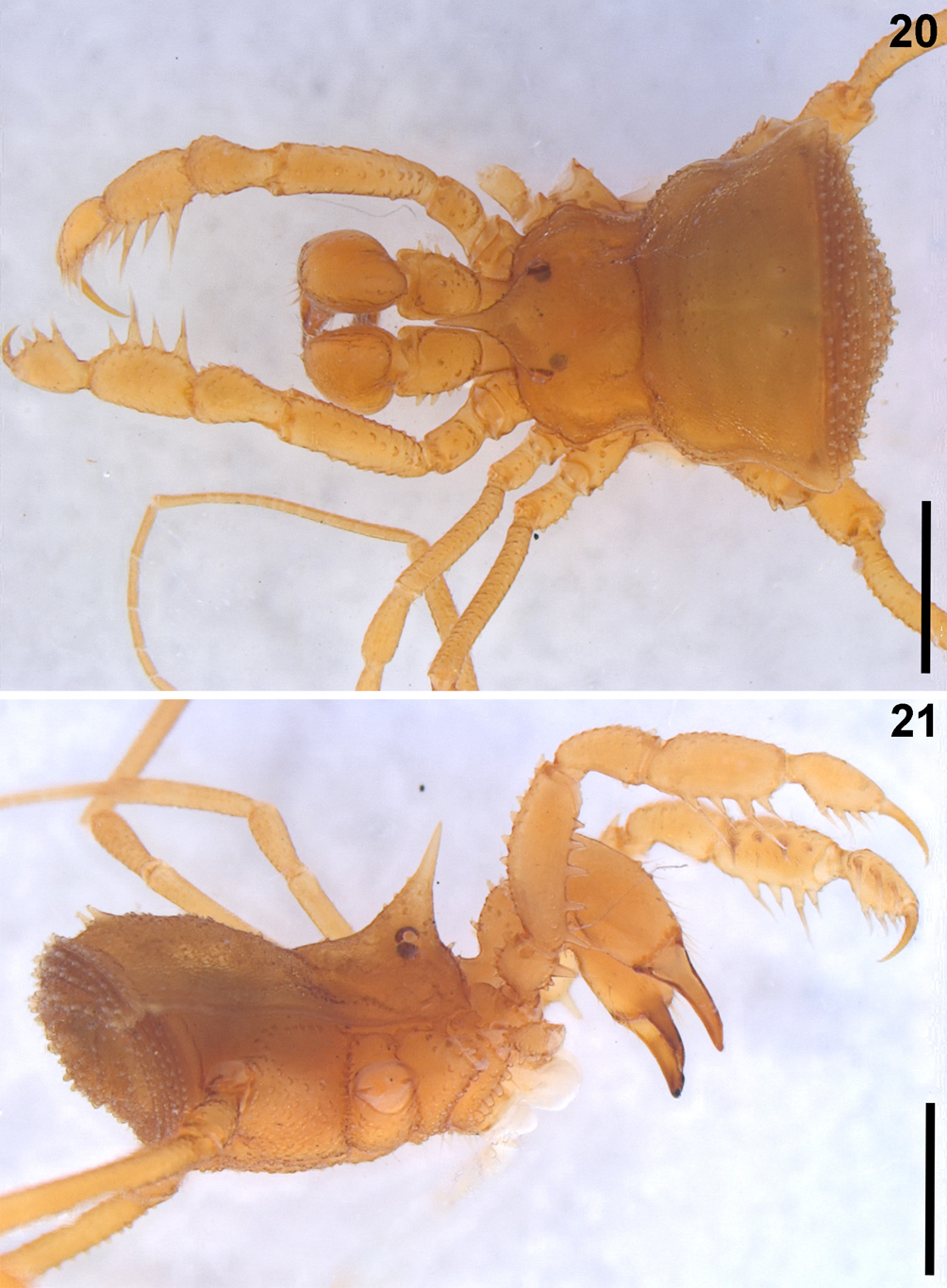
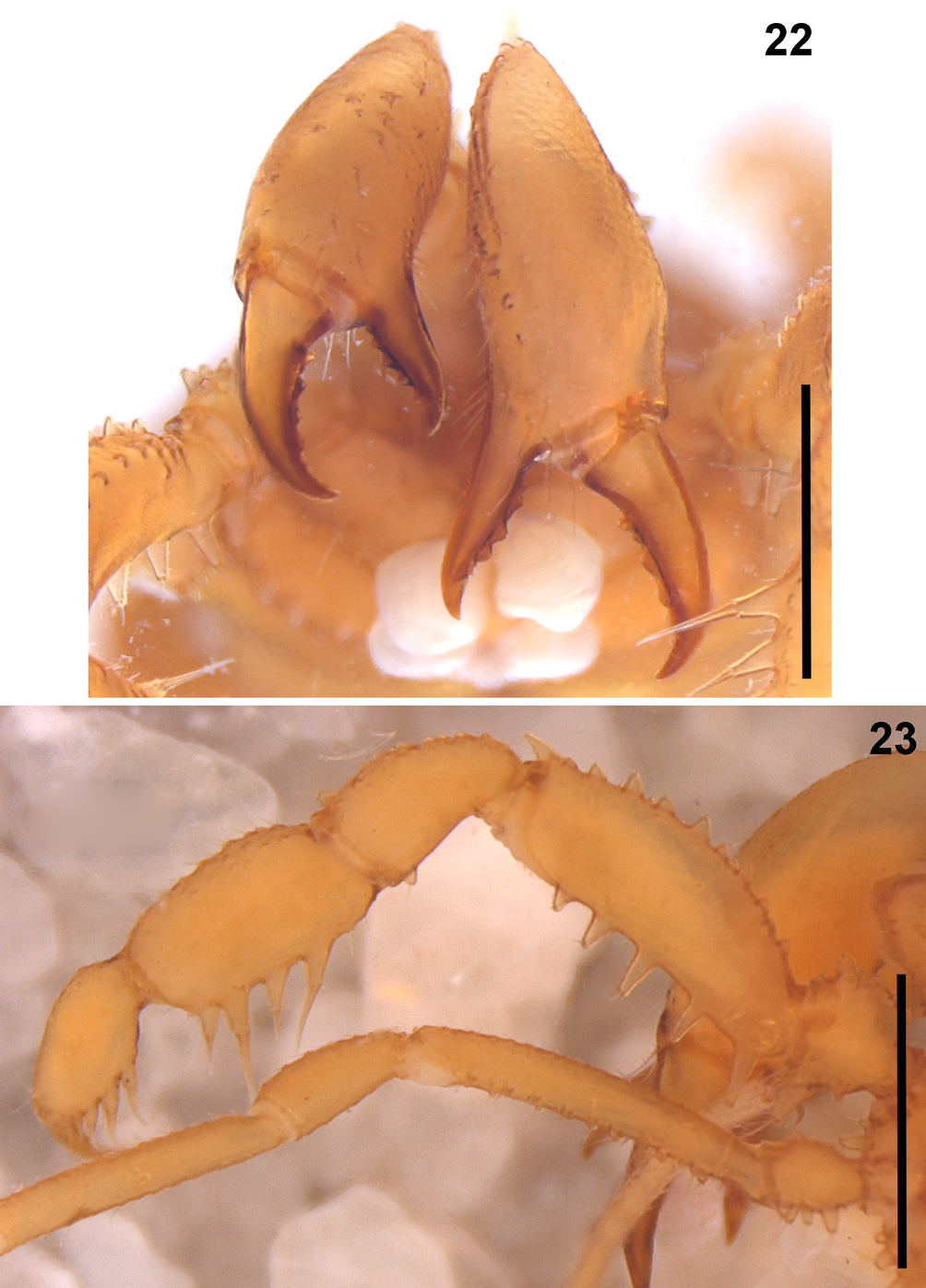
Female. Similar to male, but with the chelicerae smaller, armature of pedipalps and ornamentation of legs less developed.
Taxonomic summary
Type material: male holotype (BMNH) from Córdoba, Veracruz, Mexico, no date, no collector, photographs examined.
Additional material examined: 2 males (CNAN) from San Andrés Tenejapan, (18º47’34.86” N, 97º06’11.88” W) Tenejapan, Veracruz, Mexico, March 24, 2007 (O. Francke, C. Santibáñez, H. Montaño, A. Valdez, A. Ballesteros, colls.). Male (CNAN) from Instituto Superior de Zongolica, Zongolica, Veracruz, January 23, 2010. (O. Francke, J. Cruz, C. Santibáñez, A. Valdez). Six males and 4 females (CNAN) from Sótano de la Cruz de los Naranjos (18º56’38.36” N, 96153’13.74” W) Amatlán de los Reyes, Veracruz, April 14, 2011 (O. Francke, J. Cruz, G. Contreras, J. Bokma, P. León, C. Solis, J. Coria, P. Jiménez, colls.). Male and female (CNAN) from Sótano de la fertilidad y Sótano desbloqueado (18º56’38.36” N, 96º53’13.74” W) Amatlán de los Reyes, Veracruz, April 14, 2011 (O. Francke, J. Cruz, G. Contreras, J. Bokma, P. León, C. Solis, J. Coria, P. Jiménez, colls.). Female (CNAN) from Cueva Ojo de Agua (18º48’20.34” N, 97º06’03.72” W) Tlilapan, Veracruz, 03 January, 2012 (O. Francke, J. Cruz, C. Santibáñez, A. Valdez).
Isaeus philippii (Roewer, 1949) comb. nov.
Tampiconus philippii Roewer, 1949: 50; Kury and Cokendolpher, 2000: 156; Kury, 2003: 240; Cruz-López and Francke, 2017: 330.
Diagnosis
Five teeth on fixed cheliceral finger on female holotype.
Redescription (female). Scutum length 3.8 mm. Scutum zeta type ((ζ)), mid-bulge smooth, posterior margin much wider than scutum width at level of mid-bulge. Ocularium at the frontal margin of scutum, robust, with the base elliptical and apically armed with a contiguous large spine. Dorsum with many small tubercles. Sulcus I and II slightly curved, areas III and IV barely fused. Area III with a pair of small paramedian acute spines, pointing backward. Free tergites and anal plate covered by a transversal row of spiniform tubercles (Figs. 20, 21). Venter: all ventral area covered by small tubercles, coxae IV slightly larger than coxae III, stigmatic area inverse T-shaped. Chelicera: basichelicerite short, bulla well marked and ornate with spiniform tubercles. Cheliceral hand swollen, dorsally elevated. Frontal section of cheliceral hand with many long setae. Fixed finger with 5 small teeth, movable finger with 5 teeth (Fig. 22). Pedipalp: trochanter globular, armed with some spiniform setiferous tubercles ventrally and dorsally. Femur compressed laterally, mesal face smooth. Pedipalpal femur with a row of 5 long spiniform setiferous tubercles ventrally, the distal-most smaller; dorsally with many spiniform tubercles and apical spiniform apophysis. Patella with a ventral and a dorsal spiniform tubercles, respectively. Tibia with IiIi (1 = 3 > 2 = 4), and tarsus with IIII (1 > 2 > 3 > 4) setiferous spiniform tubercles on both margins, respectively. Tarsal claw similar in length to tarsus (Figs. 21, 23). Legs: I to IV ornate with small tubercles, without apophysis of spiniform tubercles, tarsal count unknown.
Taxonomic summary
Type material: female holotype (SMF RII 2511/66) from Tampico, Tamaulipas, no date, no collector, photographs examined.
Discussion
Isaeus resembles Hoplobunus in the external and genital morphologies; however, in the total evidence phylogeny of Stygnopsidae proposed by Cruz-López and Francke (2017), Isaeus (“Hoplobunus” sp. 0033) was recovered as a monophyletic group completely unrelated with Hoplobunus. Isaeus is the sister group of the clade that includes Paramitraceras (except P. hispidulum), Philora, Serrobunus, Sbordonia, and Troglostygnopsis; and Hoplobunus was recovered as the sister group of Stygnopsis (Cruz-López & Francke, 2017). Before the examination of the holotype of I. neglectus, Cruz-López and Francke (2017) included in their total evidence analysis 2 undetermined Hoplobunus, with “Hoplobunus” sp. 0033 as a DNA voucher from Sótano de la Fertilidad y Sótano desbloqueado, Amatlán de los Reyes, Veracruz, which actually is I. neglectus. Despite the fact that Cruz-López and Francke (2017) could not obtain DNA samples of I. philippii, the examination of the morphology of the female holotype was enough to recovered I. neglectus + I. philippii as a clade with high support. The presence of 2 paramedian acute spines on the mesotergal area III pointing backward is a homoplastic morphological character shared between Isaeus and Stygnopsis mexicana Roewer, 1915, Stygnopsis robusta (Goodnight & Goodnight, 1971), and Stygnopsis valida (Sørensen, 1884). Despite the extreme similarity in male genitalia morphologies between Hoplobunus and Isaeus, Isaeus can be recognized from Hoplobunus by the absence of small MS E, 3 MS C nearly in ventral position and MS A and B at the same level, respectively.
Acknowledgments
The senior author thanks the Posgrado en Ciencias Biologicas, UNAM, and Conacyt for a scholarship during graduate studies. To Peter Jaeger, Senckenberg Forschunginstitut und Naturmuseum, Frankfurt am Main, Germany for kindly sending the holotype of Tampiconus phillipii to Bonn, where it was photographed by Alejandro Valdez. Likewise, we are indebted to Janet Beccaloni, Stuart Longhorn, and Daniella Sherwood of the British Museum of Natural History, London, for providing photographs of the holotype of Isaeus mexicanus. We thank Osvaldo Villarreal and A. Valdez for their suggestions on the manuscript. Scanning electron photographs were made with the assistance of Berenit Mendoza (LaNaBio).
References
Acosta, L. E., Pérez-González, A., & Tourinho, A. L. (2007). Methods for taxonomic study. In R. Pinto-da Rocha, R., G. Machado, & G. Giribet (Eds.), Harvestmen: the biology of Opiliones (pp. 494–505). Cambridge, MA: Harvard University Press.
Cruz-López, J. A., & Francke, O. F. (2013). Two new species of the genus Paramitraceras Pickard-Cambridge, 1905 (Opiliones: Laniatores: Stygnopsidae) from Chiapas, Mexico. Zootaxa, 3641, 481–490.
Cruz-López, J. A., & Francke, O. F. (2017). Total evidence phylogeny of the North American harvestman family Stygnopsidae (Opiliones: Laniatores: Grassatores) reveals hidden diversity. Invertebrate Systematics, 31, 317–360.
Goodnight, C. J., & Goodnight, M. L. (1953). The opilionid fauna of Chiapas, Mexico, and adjacent areas (Arachnoidea, Opiliones). American Museum Novitates, 1610, 1–81.
Kury, A. B. (2003). Annotated catalogue of the Laniatores of the New World. Revista Ibérica de Aracnología (volumen especial monográfico), 1, 1–337.
Kury, A. B., & Cokendolpher, J. C. (2000). Opiliones. In J. Llorente-Bousquets, J. E. González-Soriano, & N. Papavero (Eds.), Biodiversidad, taxonomía y biogeografia de artrópodos de México: hacía una síntesis de su conocimiento, Vol. II (pp. 137–157). México City: Facultad de Ciencias, UNAM/ Conabio/ Bayer.
Kury, A. B., & Medrano, M. (2016). Review of terminology for the outline of dorsal scutum in Laniatores (Arachnida, Opiliones). Zootaxa, 4097, 130–134.
Kury, A. B., & Villarreal, O. (2015). The prickly blade mapped: establishing homologies and a chaetotaxy for macrosetae of penis ventral plate in Gonyleptoidea (Arachnida, Opiliones, Laniatores). Zoological Journal of the Linnean Society, 174, 1–46.
Mello-Leitão, C. F. (1938). Considerações sobre os Phalangodoidea Soer. Com descrição de novas formas. Annaes da Academia Brasileria de Sciencias, 10, 135–145.
Roewer, C. F. (1949). Über Phalangodiden I. (Subfam. Phalangodinae, Tricommatinae, Samoinae). Weitere Weberknechte XIII. Senckenbergiana, 30, 11–61.



